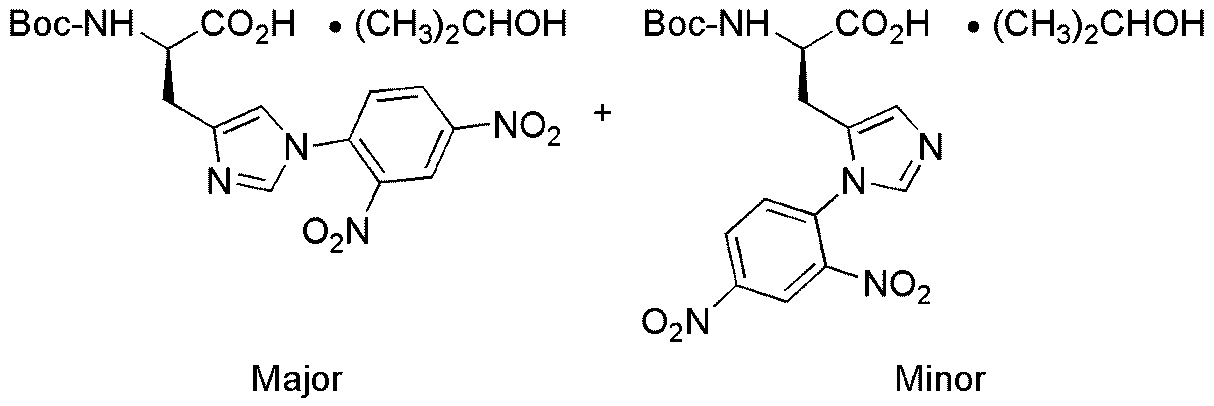Na-Boc-Nim-2,4-dinitrophenyl-D-histidine·isopropanol is widely utilized in research focused on:
- Peptide Synthesis: This compound serves as a protective group in the synthesis of peptides, allowing for the selective modification of amino acids without affecting the overall structure. This is crucial in developing complex peptides for pharmaceuticals.
- Drug Development: Its unique structure aids in the design of novel drug candidates, particularly in targeting specific biological pathways. Researchers can modify the compound to enhance efficacy and reduce side effects.
- Bioconjugation: The compound is used in bioconjugation processes, where it helps attach drugs or labels to biomolecules. This is particularly beneficial in creating targeted therapies and diagnostic agents in cancer treatment.
- Analytical Chemistry: It plays a role in analytical methods, such as chromatography and mass spectrometry, helping to identify and quantify biomolecules in complex mixtures, which is essential for quality control in pharmaceuticals.
- Research in Immunology: The compound is utilized in the development of immunoassays, aiding in the detection of specific antibodies or antigens, which is vital for vaccine development and disease diagnosis.
General Information
Properties
Safety and Regulations
Applications
Na-Boc-Nim-2,4-dinitrophenyl-D-histidine·isopropanol is widely utilized in research focused on:
- Peptide Synthesis: This compound serves as a protective group in the synthesis of peptides, allowing for the selective modification of amino acids without affecting the overall structure. This is crucial in developing complex peptides for pharmaceuticals.
- Drug Development: Its unique structure aids in the design of novel drug candidates, particularly in targeting specific biological pathways. Researchers can modify the compound to enhance efficacy and reduce side effects.
- Bioconjugation: The compound is used in bioconjugation processes, where it helps attach drugs or labels to biomolecules. This is particularly beneficial in creating targeted therapies and diagnostic agents in cancer treatment.
- Analytical Chemistry: It plays a role in analytical methods, such as chromatography and mass spectrometry, helping to identify and quantify biomolecules in complex mixtures, which is essential for quality control in pharmaceuticals.
- Research in Immunology: The compound is utilized in the development of immunoassays, aiding in the detection of specific antibodies or antigens, which is vital for vaccine development and disease diagnosis.
Documents
Safety Data Sheets (SDS)
The SDS provides comprehensive safety information on handling, storage, and disposal of the product.
Product Specification (PS)
The PS provides a comprehensive breakdown of the product’s properties, including chemical composition, physical state, purity, and storage requirements. It also details acceptable quality ranges and the product's intended applications.
Certificates of Analysis (COA)
Search for Certificates of Analysis (COA) by entering the products Lot Number. Lot and Batch Numbers can be found on a product’s label following the words ‘Lot’ or ‘Batch’.
*Catalog Number
*Lot Number
Certificates Of Origin (COO)
This COO confirms the country where the product was manufactured, and also details the materials and components used in it and whether it is derived from natural, synthetic, or other specific sources. This certificate may be required for customs, trade, and regulatory compliance.
*Catalog Number
*Lot Number
Safety Data Sheets (SDS)
The SDS provides comprehensive safety information on handling, storage, and disposal of the product.
DownloadProduct Specification (PS)
The PS provides a comprehensive breakdown of the product’s properties, including chemical composition, physical state, purity, and storage requirements. It also details acceptable quality ranges and the product's intended applications.
DownloadCertificates of Analysis (COA)
Search for Certificates of Analysis (COA) by entering the products Lot Number. Lot and Batch Numbers can be found on a product’s label following the words ‘Lot’ or ‘Batch’.
*Catalog Number
*Lot Number
Certificates Of Origin (COO)
This COO confirms the country where the product was manufactured, and also details the materials and components used in it and whether it is derived from natural, synthetic, or other specific sources. This certificate may be required for customs, trade, and regulatory compliance.

